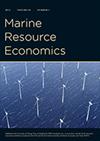发展中沿海国家作为金枪鱼饵料和当地社区食物的鳀鱼资源的最佳配置
IF 1.7
3区 经济学
Q2 ECONOMICS
引用次数: 2
摘要
发展中国家的金枪鱼渔船经常与个体渔民争夺凤尾鱼等小型中上层物种。由于金枪鱼捕捞的资本密集性质,这些船只的特点是外国所有;渔获物出口;他们向东道国支付访问费。相比之下,手工独木舟归国民所有,上岸的鱼在当地消费。此外,鱼类聚集装置(FAD),如用于捕捉饵鱼的人造灯,破坏了海洋生态系统。本文建立了一个鱼类资源分配的生物经济模型,该模型考虑了金枪鱼渔船的所有权和破坏性捕鱼行为造成的环境机会成本。从模型中,我验证了在不同情景下,次优均衡解偏离社会最优结果的程度。此外,我推导了一个最优(从价)税的表达式,该表达式足以使这两种股票的租金最大化。利用加纳金枪鱼和凤尾鱼捕捞的数据对最佳解决方案进行了表征。本文章由计算机程序翻译,如有差异,请以英文原文为准。
Optimal Allocation of Anchovy Stocks as Baitfish for Tuna and as Food for Local Communities in Developing Coastal Countries
Bait tuna vessels in developing coastal countries often compete with artisanal fishers for small pelagic species such as anchovies. Owing to the capital-intensive nature of tuna fishing, the vessels are characteristically foreign owned; the catches are exported; and they pay access fees to the host country. By contrast, the artisanal canoes are owned by the nationals and the fish landed are consumed locally. In addition, fish aggregating devices (FADs), such as artificial lights used to catch the baitfish, destroy marine ecosystems. In this paper a bioeconomic model for fish resource allocation, which accounts for the ownership of the tuna fishing vessels and environmental opportunity costs owing to destructive fishing practices, has been developed. From the model, I have verified the extent to which suboptimal equilibrium solutions deviate from social optimal outcomes under different scenarios. Moreover, I have derived an expression for optimal (ad valorem) tax enough to maximize rents from the two stocks. The optimum solutions are characterized using data on tuna and anchovy fishing in Ghana.
求助全文
通过发布文献求助,成功后即可免费获取论文全文。
去求助
来源期刊

Marine Resource Economics
农林科学-渔业
CiteScore
4.30
自引率
10.30%
发文量
25
审稿时长
>12 weeks
期刊介绍:
Marine Resource Economics (MRE) publishes creative and scholarly economic analyses of a range of issues related to natural resource use in the global marine environment. The scope of the journal includes conceptual and empirical investigations aimed at addressing real-world oceans and coastal policy problems. Examples include studies of fisheries, aquaculture, seafood marketing and trade, marine biodiversity, marine and coastal recreation, marine pollution, offshore oil and gas, seabed mining, renewable ocean energy sources, marine transportation, coastal land use and climate adaptation, and management of estuaries and watersheds.
 求助内容:
求助内容: 应助结果提醒方式:
应助结果提醒方式:


